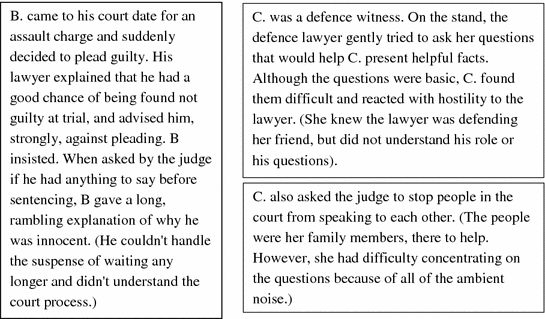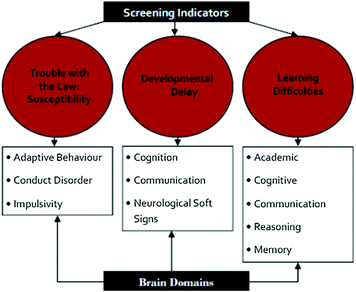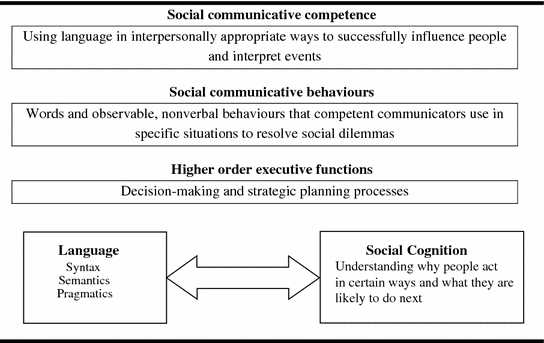Fig. 1
Neuropsychological domains
As a model, Fig. 1 is rather static, and fails to capture the dynamic and interactive nature of human communication. A better model for our purposes is that found in Coggins et al. (2007) (see Fig. 2). They termed this model “a framework of social communication”, which it is, and highlighting the social nature of language enables us to focus on the aspects we saw in the opening vignette from Dianne Yee. They concern the fact that what one person in the interaction had in their mind as to what was going on was different to what the others had in theirs. Both, however, assumed that the others had the same expectations and interpretations that they themselves did. Hence language is about, as Fig. 2 says “influencing people and interpreting events”, with certain associated behaviours and decision-making and planning, which all centrally depend on mutually held understandings.
So what happens when this mutual understanding does not hold? Mostly what happens is that the representative(s) of the majority (typical person, normal language user) assumes the other actually does understand the same things they do, and therefore inaccurately attributes their behaviours as deliberate violations of these mutual expectations. These actions are assumed to arise by choice or from defects of character or behaviour. The other person is felt to be “aggressive”, “uncooperative”, “arrogant”, and/or “criminal”, and hence deserved everything that happened to them. This is very evident in the parent experience we saw at the beginning of the chapter.
This understanding of language and language skills as central to interactions and of the role of mutual understanding and its failures, helps us see why the consequences of language difficulties can be so overwhelming. The website “Fetal Alcohol Spectrum Disorder and Justice” (http://www.fasdjustice.ca/) presents a number of vignettes which illustrate this (see Boxes): At best the behaviour of the person concerned seems inconsistent, out to fool others or to lie. Because this is so puzzling to interpret, even experts in young people and/or in the law can find themselves assuming the worst possible interpretation.

The Consequences of Language Difficulties in FASD
Conry and Fast (2000) said “People with FASD even when not mentally handicapped, have great difficulty understanding and processing language; in this regard they may be unintentionally abused by the system” (pp. 34–35). The boxes above have prepared us for this conclusion.
Language is involved in every stage of the legal process. An initial encounter with the police or other front-line staff and a young person can often go either way, depending on how the young person communicates. Are they able to ‘talk their way out of it’? Present a credible case for themselves? Recognise what it is that the front-line person is likely to want to hear, in terms of explanation and appropriate recognition of the rights of others? If they are, there may be few, if any, consequences beyond that point. Should it go further, are they able to explain their story to a lawyer or advocate so that person can present their best case, and also to understand and follow the recommendations and expectations of that lawyer or advocate? Are they able to understand the processes and language of the court, and the meaning of judges’ rulings, of orders or sentences, and what they now need to do? If placed in a rehabilitation or other programme, are they able to participate in the (usually) verbal activities central to them (many of these programmes are centred around the ‘talking therapies’), and to comprehend what they are expected to achieve from it?
There is ample evidence that a high proportion of young people in the justice systems of the UK, Australia and the USA, have oral language difficulties. The figure most commonly cited is 50–60 %, compared to some 7–12 % of their peers (see Snow and Powell 2012, for a summary). An unknown number of these young people are on the spectrum of Fetal Alcohol Disorders. Hughes et al. (2012) showed very high numbers of neurodevelopmental disabilities in their populations of young people who offend in the UK, of which the most highly represented is communication difficulties (cited as 60–90 %). FASD is listed as a lower figure—11–12 %—but they recognise that diagnosis is unlikely to be consistently made with this group. Some of the higher figure young people would also be in the FASD group if properly assessed.
So significant is this that Conry and Fast (2000 p. 25) considered that trouble with the law is a screening indicator for FASD, as shown in their diagram below.

If ‘trouble with the law’ is a screening indicator, then it is clear that the problems concerned are being detected far too late. Hughes et al. (2012) discuss the idea that neurodisability itself (such as FASD) places a young person at risk for offending, confounded with other known risk factors such as truancy, poor socialisation, inconsistent nurturing and school failure. Some children with FASDs may have a history of dysfunctional caregiving and are at risk of co-occurring disabilities such as head injury and depression.
What Can Be Done?
The trajectory so often seen, as illustrated above, is not inevitable. What it has highlighted is that there is a need for a great deal more understanding of the problems of language difficulties within a wide range of professions and in the community. This understanding has at least two purposes; to minimise unnecessary consequences for the young person, arising from misinterpretation, and secondly to allow these disciplines and persons to begin to make adaptations; to their interaction patterns, to instruments of assessment, and to interventions, as well as to day-to-day interactions. Early intervention is required to ensure that children’s language needs are provided for throughout their childhood to ensure that they are equipped with the language and social communication skills they need to participate in all the interactions they may have in life, whether in education, health or legal contexts.
Recognition and consistent diagnosis of FASD is still not well established except in isolated pockets. Canada has perhaps the best record to date. But ways of assessing and working with language difficulties have a longer history, and there are new interventions emerging which are proving effective in the youth justice sector (e.g. Gregory and Bryan 2009; Department of Health (UK) 2011; Lanz 2009). Additionally, work such as that of Cross (2011) has many points to contribute.
Stay updated, free articles. Join our Telegram channel

Full access? Get Clinical Tree






